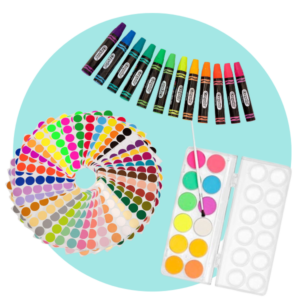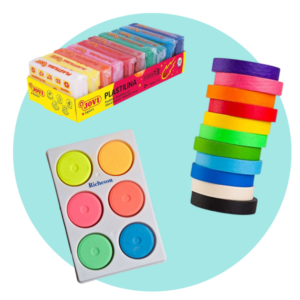I’ll be honest—we fell into the screen trap gradually, then completely.
It started innocently enough. A show during dinner prep. An iPad game during a long car ride. But somewhere along the way, screens became the default answer to boredom, and my kids forgot how to entertain themselves.
When I’d suggest they go play, I’d hear “But what should I do?” They’d lost the ability to create their own fun without digital entertainment.
The shift didn’t happen overnight. But as we slowly reintroduced old-fashioned activities—things I’d done as a kid without even thinking about it—something changed. My kids rediscovered the satisfaction of creating, building, and imagining with their own hands and minds.
These six activities became our gateway back to screen-free play.
1) Building with actual blocks and loose parts
We had blocks sitting in the toy basket for months, largely ignored while the kids asked for tablets.
I started being intentional about it. I’d dump the blocks out on the floor after school and say, “I wonder if you could build a castle big enough for your stuffed animals to live in.”
I added loose parts—cardboard boxes, fabric scraps, toilet paper rolls, sticks from the yard, smooth stones. Suddenly building wasn’t just about stacking blocks. It was about creating whole worlds.
My daughter started building elaborate fairy houses with blocks as the foundation and fabric as curtains. My son built garages and ramps for his toy cars, spending an hour figuring out the right angle.
The key was giving them enough uninterrupted time. When I left them alone for an hour, they’d get lost in it.
Now they build sprawling cities that take over the living room floor for days. They invent problems and solve them. They argue about architectural decisions and compromise on designs.
Related Stories from The Artful Parent
2) Making things with paper, glue, and scissors
I set up a permanent craft station in the kitchen—a drawer with paper, scissors, glue, tape, markers, and crayons. Nothing fancy, just the basics always available.
Then I stopped managing their crafts. I stopped suggesting what they should make or hovering to ensure they didn’t make a mess. I just made the materials available and let them figure it out.
At first they’d make one thing and declare themselves done. But without screens as a backup, they’d eventually wander back to the craft drawer.
My daughter discovered she loves making cards for people. My son started making “inventions”—paper airplanes with modifications, boats with sails, masks with moving parts.
The mess is real. There are paper scraps everywhere. But they’re creating. They’re problem-solving. And they’re doing it for the intrinsic satisfaction of making something, not for external rewards.
3) Playing outside without structure or agenda
I grew up playing outside for hours with nothing but “be home before dark” as instruction. My kids had never experienced that.
- If you can admit these 10 things about yourself, you have rare emotional maturity - Global English Editing
- The class divide no one talks about: 7 things that are “fancy” to some and “trashy” to others - Global English Editing
- 9 lessons your grandparents learned about joy that still hold true - Global English Editing
I started just sending them outside. “Go play in the yard. Come back in an hour.”
“But what should we do?”
“Whatever you want.”
The first few times were painful. They’d come back in after ten minutes saying there was nothing to do. I’d send them back out.
Gradually, they stopped asking and started doing.
They dig in the dirt. They collect rocks and sticks. They make fairy houses out of moss and leaves. They climb trees. They catch bugs and observe them.
My daughter invented an entire game involving acorns as currency. My son discovered he can make mud bricks and has been trying to build a fort.
They come inside tired and satisfied in a way that screen time never provided. They’ve used their bodies. They’ve engaged with the physical world. They’ve solved problems and created games without adult direction.
4) Cooking and baking alongside me
I used to cook while the kids watched shows. It was faster, cleaner, and less stressful.
But I realized I was missing an opportunity. So I started inviting them to help, even though it meant dinner took longer and the kitchen got messier.
Now they have regular jobs. My daughter measures ingredients. My son stirs and mixes. They both help with age-appropriate chopping and assembly.
But beyond assigned tasks, I let them experiment. We make extra dough and they create their own bread shapes. My son discovered he loves making smoothies, experimenting with different fruit combinations. My daughter has become obsessed with baking—she reads recipes and figures out what we need to buy.
They’re not just keeping busy—they’re learning practical skills. They’re understanding measurements and following sequences and seeing how ingredients transform.
And they’re proud. They tell everyone “I made this.” They’re developing competence and confidence in a real-world skill that screens can never teach.
5) Reading and being read to—a lot
We always read bedtime stories, but I realized we’d stopped reading at other times of day.
I started leaving books everywhere. On the couch, on the kitchen table, in the car. I started reading aloud at random times—while I folded laundry, during afternoon snack, on weekend mornings.
I also started letting them see me read. Not just scrolling my phone, but actually reading physical books.
When screens weren’t an option and books were readily available, even my resistant son started picking them up. Now he’ll disappear into a book for half an hour at a time.
I also stopped policing what they read. Comic books, graphic novels, magazines—if they’re reading, it counts.
The key was making books as accessible as screens used to be, and creating a culture where reading was just what we do when we have downtime.
6) Playing imaginative games with minimal props
The most surprising rediscovery has been pure imaginative play—the kind that needs almost nothing.
My kids play house for hours using nothing but a blanket fort and some stuffed animals. They play restaurant with play food and a notepad. They play school with a whiteboard and stuffed animals as students.
They create elaborate storylines that continue across multiple days. The stuffed animals have names, personalities, and ongoing dramas.
I don’t direct any of this. I barely participate unless invited. I just make sure they have enough uninterrupted time to sink into their imaginary worlds.
What I’ve noticed is that this kind of play develops when other options are removed. When screens are available, they don’t bother creating elaborate imaginary scenarios.
But when it’s just them and some basic props, their creativity emerges. They invent problems and solutions. They negotiate roles and rules. They work through social dynamics and emotions in their play.
This is the kind of play that develops emotional intelligence, creativity, and social skills. And it requires almost nothing except time, space, and the absence of more stimulating alternatives.
Conclusion
The shift away from screen dependence hasn’t been about eliminating technology. We still watch movies occasionally. Screens haven’t disappeared from our lives.
But they’re no longer the default answer to every moment of boredom or free time.
What changed was creating space for these old-fashioned activities and being patient while my kids remembered—or learned for the first time—how to entertain themselves without digital stimulation.
The first few weeks were hard. There was complaining. There were requests for tablets that I had to decline repeatedly.
But gradually, they stopped asking. They started playing. They rediscovered the satisfaction of creating something with their own hands, of getting lost in a book, of inventing games with nothing but imagination.
Now I watch my kids spend entire afternoons building, creating, playing, reading—and they’re genuinely engaged. Not passively consuming but actively creating.
These activities aren’t revolutionary. They’re what children did for generations before screens existed. But in a world where digital entertainment is always one click away, they require intentional reintroduction.
If your kids have forgotten how to play without screens, these old-fashioned activities might be the bridge back. Not as occasional special activities, but as the new normal.
Your kids might resist at first. But give it time. Give them boredom without immediate rescue. Give them materials without direction. Give them space without entertainment.
They’ll remember how to play. Or they’ll figure it out for the first time.
That’s a skill that will serve them far longer than any screen ever could.










